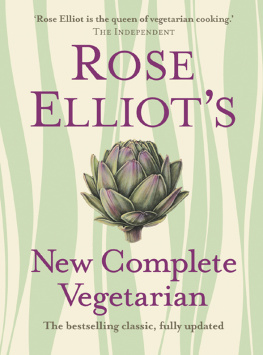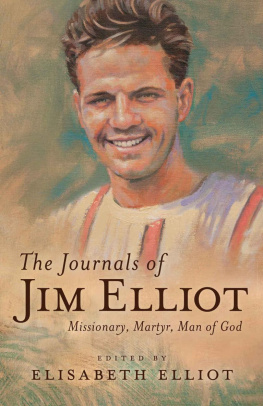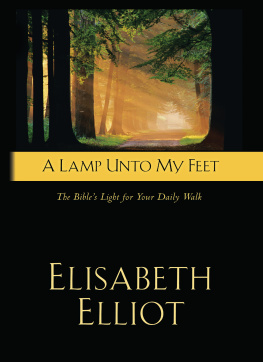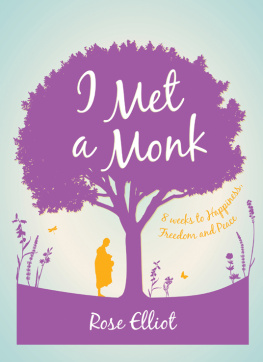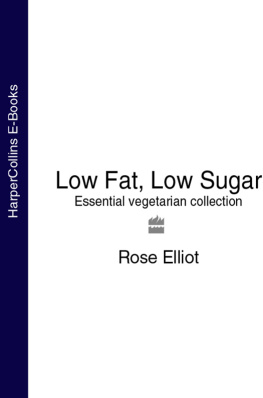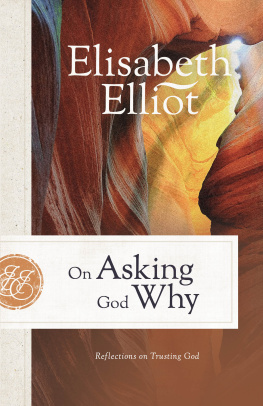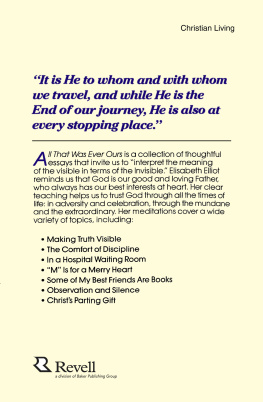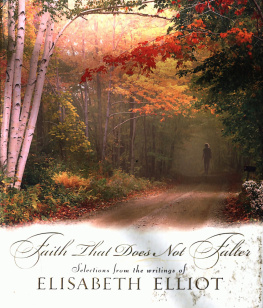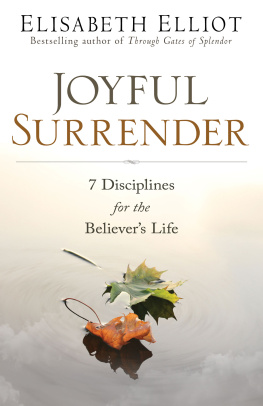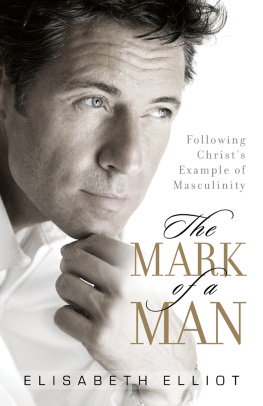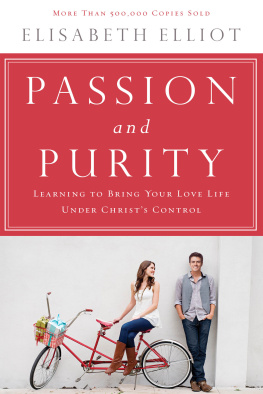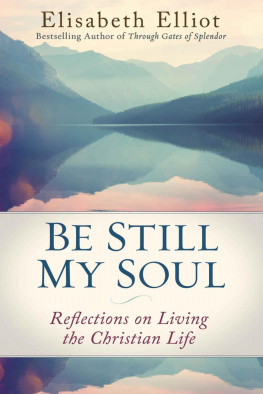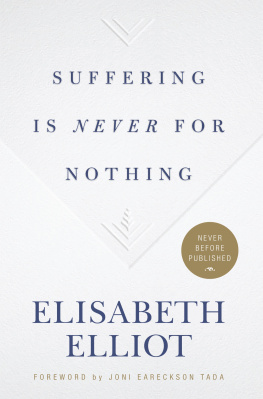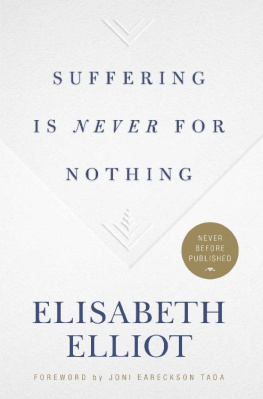Elliot - A Path Through Suffering
Here you can read online Elliot - A Path Through Suffering full text of the book (entire story) in english for free. Download pdf and epub, get meaning, cover and reviews about this ebook. City: Ventura;Calif, year: 2004;2011, publisher: Baker Publishing Group;Regal Books, genre: Religion. Description of the work, (preface) as well as reviews are available. Best literature library LitArk.com created for fans of good reading and offers a wide selection of genres:
Romance novel
Science fiction
Adventure
Detective
Science
History
Home and family
Prose
Art
Politics
Computer
Non-fiction
Religion
Business
Children
Humor
Choose a favorite category and find really read worthwhile books. Enjoy immersion in the world of imagination, feel the emotions of the characters or learn something new for yourself, make an fascinating discovery.
A Path Through Suffering: summary, description and annotation
We offer to read an annotation, description, summary or preface (depends on what the author of the book "A Path Through Suffering" wrote himself). If you haven't found the necessary information about the book — write in the comments, we will try to find it.
A Path Through Suffering — read online for free the complete book (whole text) full work
Below is the text of the book, divided by pages. System saving the place of the last page read, allows you to conveniently read the book "A Path Through Suffering" online for free, without having to search again every time where you left off. Put a bookmark, and you can go to the page where you finished reading at any time.
Font size:
Interval:
Bookmark:
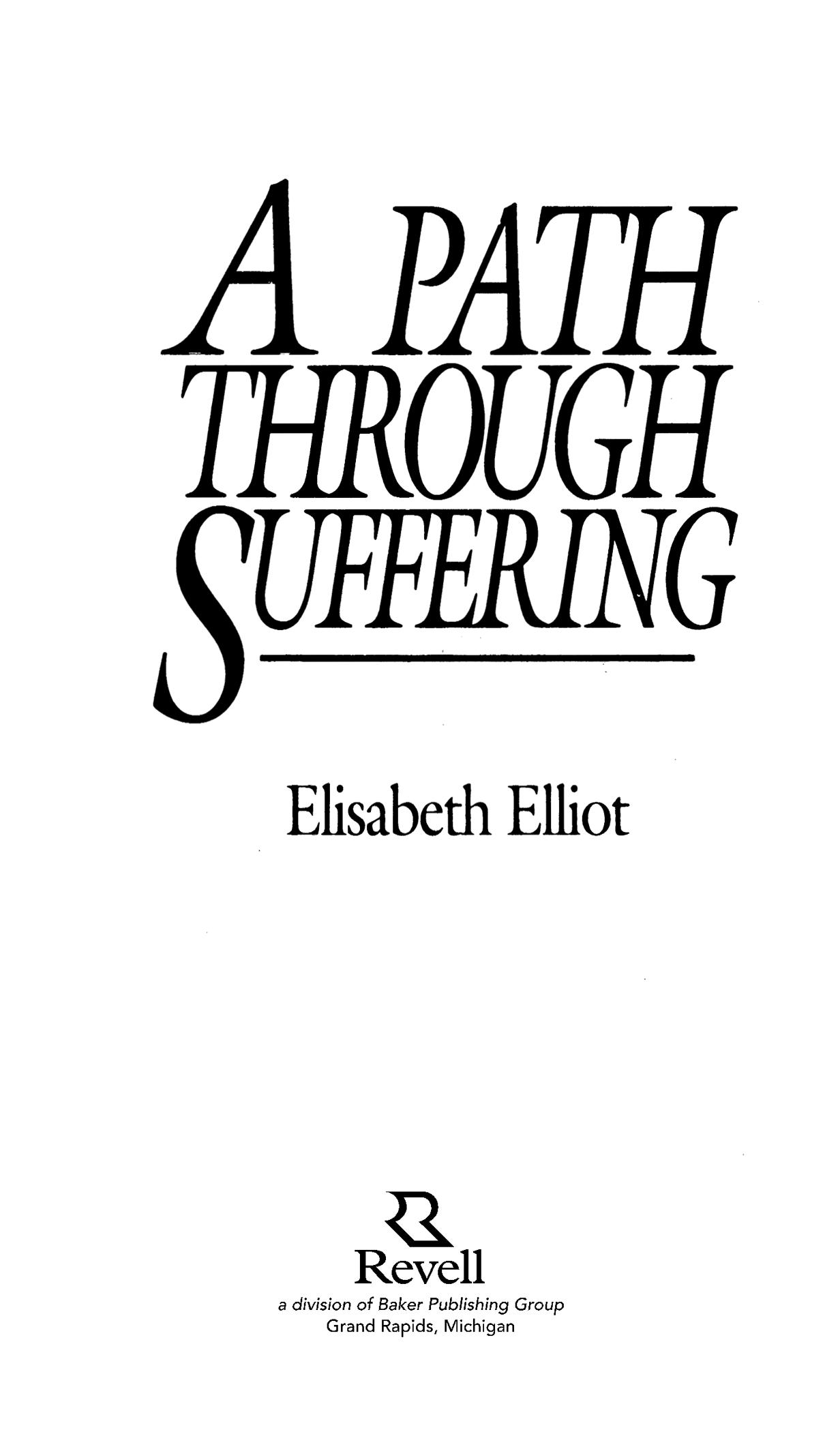
1990 Elisabeth Elliot Gren
Published by Revell
a division of Baker Publishing Group
P.O. Box 6287, Grand Rapids, MI 49516-6287
www.revellbooks.com
Revell edition published 2014
ISBN 978-1-4412-2495-8
Previously published by Regal Books
Originally published by Servant Publications in 1990.
Ebook edition originally created 2012
Ebook corrections 11.06.2015
All rights reserved. No part of this publication may be reproduced, stored in a retrieval system, or transmitted in any form or by any meansfor example, electronic, photocopy, recordingwithout the prior written permission of the publisher. The only exception is brief quotations in printed reviews.
Library of Congress Cataloging-in-Publication Data is on file at the Library of Congress, Washington, DC.
Unless otherwise indicated, scripture quotations are taken from The New English Bible. The Delegates of Oxford University Press and The Syndics of the Cambridge University Press 1961, 1970, 1989. Reprinted by permission.
Other versions used are:
AVAuthorized Version of 1611 (King James Version of the Bible). Public domain.
JBThe Jerusalem Bible (JB), copyright c 1966, 1967 and 1968 by Darton, Longman & Todd Ltd. and Doubleday, a division of Random House, Inc. All rights reserved.
JBPJ.B. Phillips: The New Testament in Modern English, Revised Edition (PHILLIPS). Copyright c J.B. Phillips 1958, 1960, 1972. Used by permission of Macmillan Publishing Co., Inc.
RSVFrom the Revised Standard Version of the Bible, copyright 1946, 1952, and 1971 by the Division of Christian Education of the National Council of the Churches of Christ in the U.S.A Used by permission.
Cover design by Michael Andaloro
Illustrations by James N. Howard
AUTHORS NOTE
Pronouns referring to the divinity are capitalized except in quotations from Scripture. In my opinion this makes for clarity.
Other books by Elisabeth Elliot
A Lamp Unto My Feet
Love Has a Price Tag
The Liberty of Obedience
The Savage My Kinsman
Shadow of the Almighty
These Strange Ashes
Let Me Be a Woman
The Mark of a Man
Passion and Purity
Discipline: The Glad Surrender
Loneliness
On Asking God Why
A Chance to Die: The Life and
Legacy of Amy Carmichael
To Bunny
(Elizabeth Paeth Lasker)
who, as physician, has given so much more than medicine;
as mother of five knows the suffering and the courage of love;
and as my friend has understood.
Contents
ACKNOWLEDGMENTS
My sincere thanks are due to Ann Spangler and Mary Case of Servant Publications for their help, and to all who generously allowed me to use their stories.
Preface
AMONG THE VISITORS TO ISAK DINESENS FARM in Africa in the 1930s was a wandering Swede named Emmanuelson, who claimed to be a tragic actor. He spent one night and set off on foot the next morning for Tanganyika in spite of his hostesss warning that that was not a possible thing to do for anyone. There was no water in the Masai Reserve and the lions were bad there at that time. She heard from him later, however, that he had made it to Tanganyika and on his way had been very kindly treated by the Masai.
It was fit and becoming, I thought, that Emmanuelson should have sought refuge with the Masai, Dinesen wrote in Out of Africa, and that they should have received him. The true aristocracy and the true proletariat of the world are both in understanding with tragedy. To them it is a fundamental principle of God and the keythe minor keyto existence. They differ in this way from the bourgeoisie of all classes, who deny tragedy, who will not tolerate it, and to whom the world of tragedy means itself unpleasantness.
Perhaps this is just the key we have lost. Suffering, even in its mildest formsinconvenience, delay, disappointment, discomfort, or anything that is not in harmony with our whims and preferenceswe will not tolerate. We even reject and deny it. Stress is the result, and stress, I believe, afflicts primarily those whom Dinesen would call the bourgeoisie.
Have we missed a fundamental principle of God? Is not suffering, loss, even death itself the minor key to existence? Do we not lose our very lives by trying so hard to save them?
Being neither a theologian nor a scholar has not prevented me from pondering the principle. The measure of pain in my own life (negligible compared with the sufferings I hear about) has been sufficient to pose the question of the meaning of suffering.
Is there not wrong too bitter for atoning?
What are these desperate and hideous years?
Hast Thou not heard Thy whole creation groaning,
Sighs of a bondsman and a womans tears?
(F.W.H. Meyers: St. Paul)
The words which have illuminated for me the deepest understanding of suffering are Jesus own, In truth, in very truth I tell you, a grain of wheat remains a solitary grain unless it falls into the ground and dies; but if it dies, it bears a rich harvest. This, He told His disciples, was the key. There is a necessary link between suffering and glory.
But what difference does that make in the life of an ordinary man or woman? (This is the question I am always asking myself as I read the Bible or books about the Bible, as I hear a spiritual talk or as I try to talk to others about spiritual things: what difference ought this to make in the way I live?)
Two little books, now out of print, wonderfully expand on the imagery Jesus used, and have greatly helped me to understand the principle. They are Lilias Trotters Parables of the Cross and Parables of the Christ-Life.
Lilias Trotter was born in London in 1853, seventh child of a businessman. She was tall and slender with large brown eyes, an active and orderly mind, and a quality of selflessness which gave her a peculiar charm. When she was twenty-three she met John Ruskin in Venice, who recognized her gift for painting and offered to give her lessons. She seemed to learn everything the instant she was shown it, he wrote, and ever so much more than she was taught. But her heart was elsewhere. She had put herself, her &s, her life at Gods disposal, so it was a great disappointment to Ruskin and a surprise to others when she decided to give herself to missionary work. She was criticized and even ostracized, but her enthusiasm was fed, not quenched, by scorn.
For some reason, North Africa awakened strange vibrations in her soul. She heard what she believed was Gods specific call, and in 1888 landed in Algiers, where she spent the rest of her life. She was the founder of the Algiers Mission Band which later merged with the North Africa Mission. She died in 1928.
She found in the plant life of the deserts the fundamental principle of existencethat death is the gateway to lifeexhibited in a thousand ways, and painted them with her brush and watercolors. Who is to say she was a fool for turning her back on home, the possibilities of marriage and perhaps an artists career (these, after all, were certainly Gods good gifts)? The last of her water colors in Parables of the Cross is that of the wood sorrel, springing from an apparently useless little pile of twigs and dead leaves. She writes, God may use the things that He has wrought in us, for the blessings of souls unknown to us: as these twigs and leaves of bygone years, whose individuality is forgotten, pass on vitality still to the newborn wood sorrel. God only knows the endless possibilities that lie folded in each one of us!
Shall we not go all lengths with Him in His plans for usnot, as these green things upon the earth in their unconsciousness, but with the glory of free choice? Shall we not translate the story of their little lives into our own?
Next pageFont size:
Interval:
Bookmark:
Similar books «A Path Through Suffering»
Look at similar books to A Path Through Suffering. We have selected literature similar in name and meaning in the hope of providing readers with more options to find new, interesting, not yet read works.
Discussion, reviews of the book A Path Through Suffering and just readers' own opinions. Leave your comments, write what you think about the work, its meaning or the main characters. Specify what exactly you liked and what you didn't like, and why you think so.


